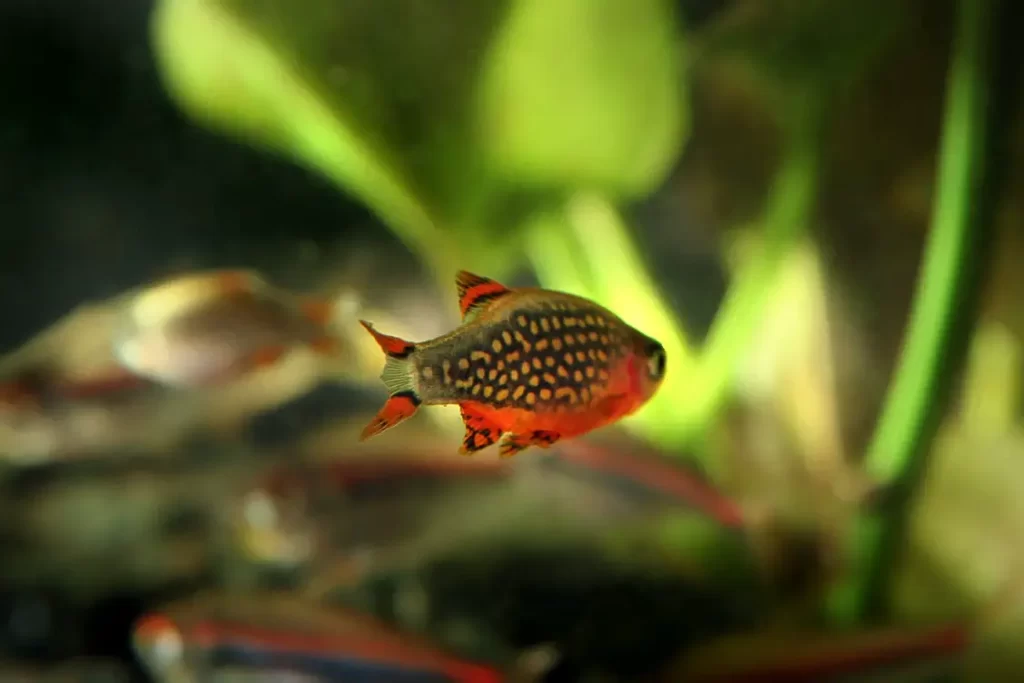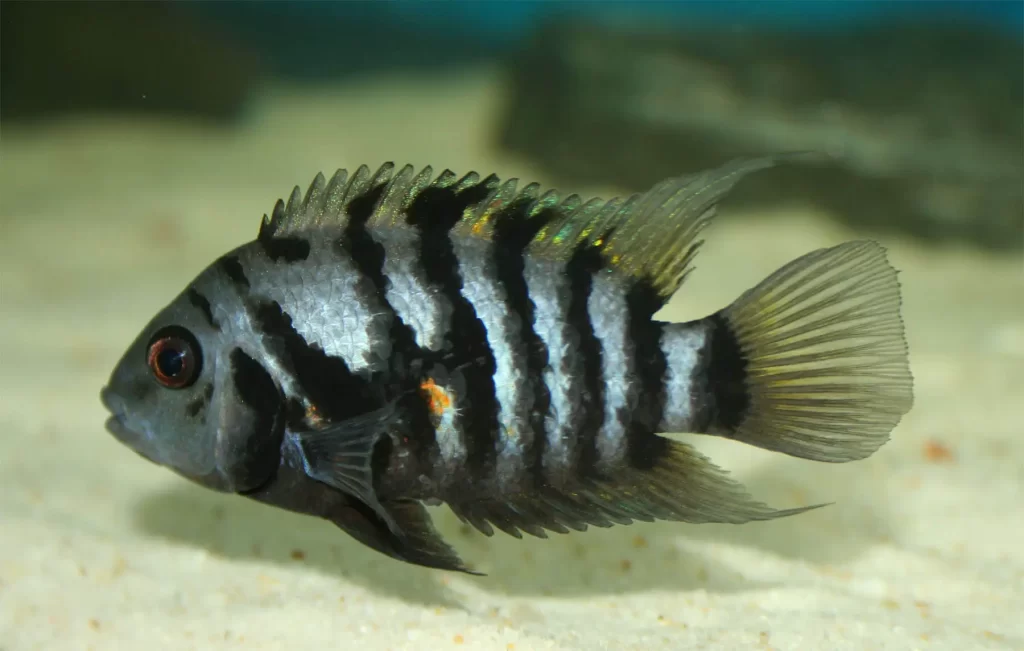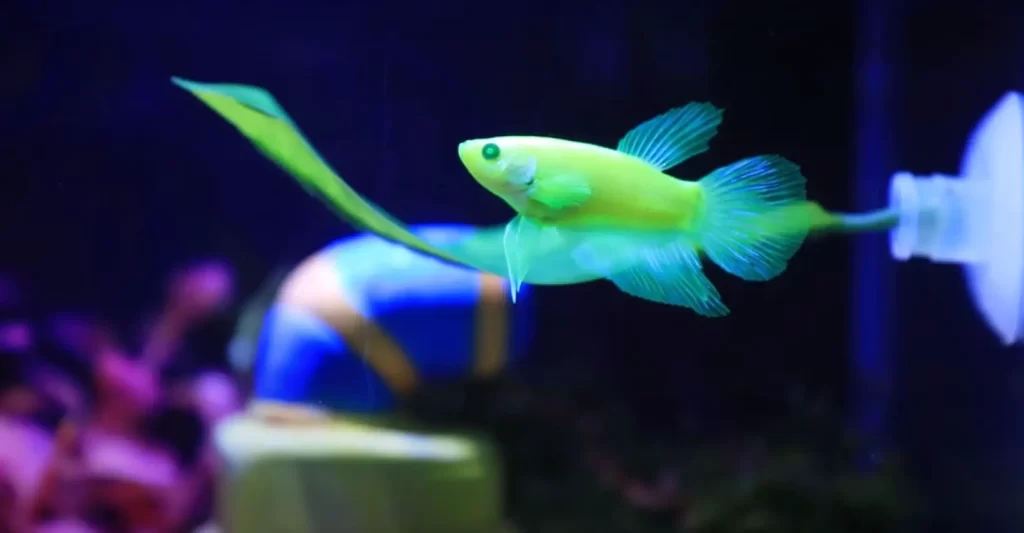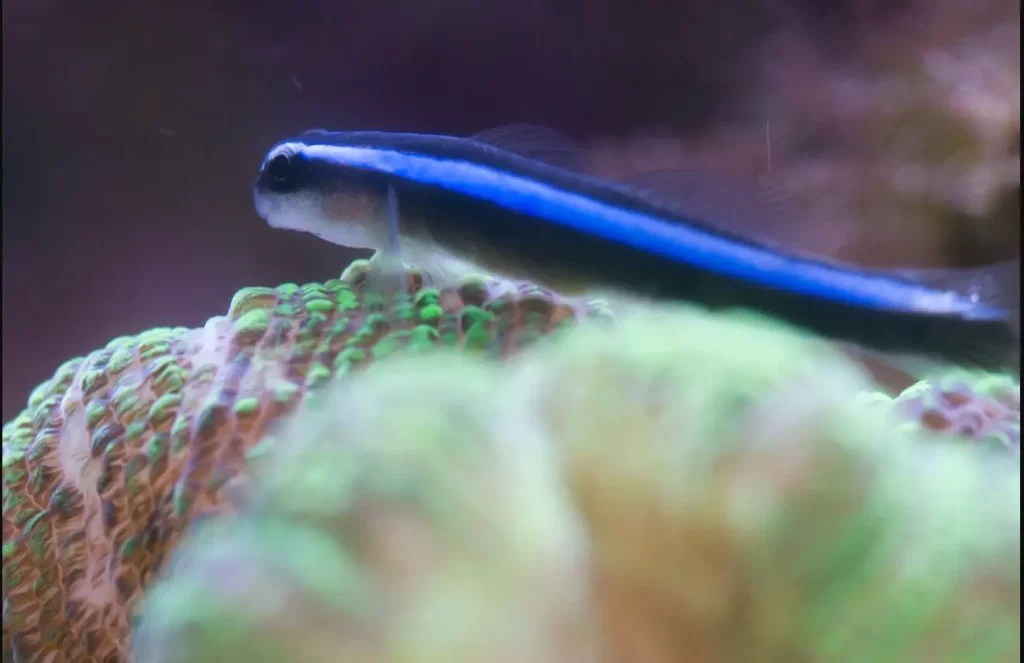Suppose you have a planted tank, then what fish would you prefer keeping in it? You surely won’t go for something with long fins and excess movement like bettas. But adding inactive fish with short fins might not give your tank the charm that you are looking for. In such a case, fish like Galaxy Rasbora comes in handy. These are truly majestic fish with small body sizes and fins. They can add coloration and life into your aquarium.
Galaxy Rasbora (scientific name: Danio Margaritatus; origin: Myanmar) is a very brightly colored fish with the maximum body length of an inch and a life span of up to 4 years. They are shy and need extreme care regarding their water parameter(even though they are hardy fish). Galaxy Rasbora is omnivorous and is not a picky eater. Although Galaxy rasboras are not shoaling fish, I recommend you keep them on a group of at least five. They also well with fish of its same size. Don’t put Galaxy rasbora with bullying and larger fish.
In this article, we will be looking at the basic guide of galaxy rasbora. These fish are quite hardy and can be ideal for beginners. So, you must learn about them before deciding to keep them. After reading this, you will know a lot about these fish and decide to keep them.
Introduction To Galaxy Rasbora
The Celestial Pearl Danio or the Galaxy Rasbora was discovered in 2006. Scientifically known as Danio Margaritatus, it as a member of the Cyprinidae family. Collectively known as minnows and carps, it is the largest and most diverse fish family in the animal kingdom. Goldfish, koi, and zebrafish are other popular fish of this family.
The small size and bright colors have made it a popular choice among fish-keepers. The fish adds plenty of color and movement into your aquarium. Due to the peaceful and socializing nature, it goes with most of the other fish with similar size and temperament.
Origin And Habit In The Wild
This majestic fish originates from the freshwater system of Myanmar. Until now, it has only been found in Hopong, which is at East lake Inle. This place is situated at an altitude of 1000 m above sea level. The habitat is a part of the Salween basin known in China as the Nu River.
Their natural habitat is highly vegetated shallow ponds. The slow movement and excessive light in the water allow lots of plants and algae to grow inside. These plants act as food and hiding spots for the fish. Their habitat also consists of slightly alkaline water. Because of the shallow nature, the water gets heated up quickly and remains warm throughout all seasons. Lots of their habitat is still yet to be known because they were discovered in just 2006.
Fish Appearance
Galaxy rasboras are tiny fish with maximum length reaching up to an inch. The body is covered in small dots that resemble pearls. This is where the name Pearl Danio comes from. These dots extend from the gills to the tail fins.
The fins are orange and yellow with black parallel stripes. This might be their most notable feature. The color of the spots is generally yellow, whereas the scale’s color can vary. The length of the fish is thrice its height.
You may sometimes notice various distinct differences among these fish. This is due to the presence of higher sexual dimorphism.
The gills are so transparent that you can almost see all the inner organs through them.
Male vs. Female
The males are slimmer and have more vibrant colors than the female. The females are slightly duller and rounded. Especially, the fins on the male are more decorated than on the female. The tail fin or the caudal fin is located a bit higher in males than in females. This gives the female a crooked look, whereas the male remains slim and straight.
You can also notice a tint of yellowish color on the bellies of females. The belly on the male is usually white, but it turns red while courting. You can also recognize a mature female with a black spot in her anal area.
Availability
Initially, when the fish was first discovered, hobbyists considered it to be rare. So, they would just extract a few of them from ponds. Later they found out that these fish are prolific and would reproduce almost every day. So, in captivity, their number increased, and there was no need to extract them from the pond. Soon, in 2007 Myanmar banned the export of this fish. But hobbyists who already had enough of them stocked bred them and increased the number. This also reduced their price from $20 per fish to just $3 to $4 each.
Currently, IUCN has not given any conservation status to this fish because of insufficient research and data. But their abundance in captivity indicates that they are neither rare nor too hard to breed.
Lifespan
In a healthy and well-maintained tank, a galaxy rasbora can live up to 4 years. This tank must resemble the natural habitat as close as possible. For this, you will need lots of vegetation and a large enough school. You can get hem to live to their fullest by preventing them from diseases and also predators.
Price
Since people found out that these fish aren’t rare, their price has drastically dropped down. From a jaw-dropping price of around $20 to $4 per fish, they have come a long way. Since these are schooling fish and need to be kept in a school of around 5-6, the price reaches about $20. Because they are prolific fish, they will quickly multiply, and you can sell the newborn for a good price. So, it is fair to say that galaxy rasboras are pocket-friendly.
General Behavior And Tankmates
Galaxy rasboras are shy fish. They are not curious and are inactive regarding their swimming habit. These fish like to hover around in a peculiar position rather than moving around and exploring. These are also not necessarily shoaling fish, but keeping them in a group of 5-6 helps them to thrive and breed. The male and female tend to stay separated while resting.
Galaxy rasboras have a calm temperament and do well with fish of the same size and similar nature. You should never keep the with bullying and larger fish. The perfect companion for a galaxy rasbora would be neon tetras, zebra danios, and Endler’s livebearer. Guppies, corydoras, and kill-fish are also great companions for galaxy rasboras. All of these fish have similar size and calm temperament.
Bigger and aggressive fish should be avoided at all costs. Large cichlids will take them as food, so don’t even think about keeping them together. You should also avoid Oscars and bettas.
About keeping galaxy rasboras together, they are not shoaling fish. But a small group of 5-6 fish is mandatory. This group must have equal male and female.
The males don’t usually show any territorial behavior unless it is time to mate. So, if you don’t want to see any fin nipping or other aggressive behavior in a galaxy rasbora tank, then create lots of hiding spots. This is because a male might attack a less dominant male while trying to impress the female for courtship.
Fish Keeping Difficulty
Finding a suitable tankmate with similar or calmer temperament is probably the biggest problem with keeping this fish. Since it is among the calmest aquarium fish, any other fish (even the peaceful ones) will try to show dominance over them. This leads to fin nipping and constant territorial brawls.
Another problem with this fish is that even though they are for beginners, every aspect must be monitored properly. You must be strict regarding diet, water parameters, and diseases.
Despite all these difficulties, galaxy rasboras are hardy fish and are an ideal choice for new fish-keepers.
Caring For The Galaxy Rasbora
Like any other fish or pet, these fish need excessive caring. If anything goes even slightly wrong, you and the fish may have to bear severe consequences. These consequences include diseases, infertility, loss of appetite, color shed, and even death. So, you must take the necessary actions to make the tank as natural as possible. Also, the food you provide must be nutritional enough for them to thrive properly.
Below is a basic care guide of galaxy rasbora. If you are planning to keep the fish, then you must go through this guide at least once.
Fish Tank
For a small group of 5-6 fish, there should be at least 10 gallons of water. Anything below that can cause stress to the fish. If you decide to add more fish to the group, then at least 2 gallons of water must be added for each fish.
The group should contain either more females or equal sex ration. If you have more males in the tank, there will be more brawls regarding mating.
Also, the tank should be shallow rather than deep or tall. This will help them feel like home. Also, minimize the water flow to the limit.
Lightings
The natural habitat of the fish gets excessive light throughout the day. So, to replicate this, you can expose the tank to direct daylight. This will also support the growth of vegetation in the tanks, which is exactly what we and the fish need. The fish uses algae and plants as food and hiding spots.
If daylight is not possible, you can place lights that provide moderate to high lighting. During the night, you can turn off the aquarium light and let them rest.
Decoration And Substate
Plants are possible the best decorations in a galaxy rasbora tank. You can add few driftwoods and other decorations if you have space but always prioritize plants. Use stones to make small caves to act as hiding spots. You may also use commercially available caves.
Your tank should have both sprawling and tall-growing plants. This is because the fish doesn’t prefer either bottom or top but can swim anywhere in the tank. If you decide to keep driftwoods, then be sure to leach out all tannins before placing it in water. You may also grow moss in the tank as it is safe.
These fish don’t have a favorite substrate, but considering the heavy vegetation, your tank must always have sand. Sand is also biologically good for the fish, as it eats the sand in case of any digestion disorders.
Galaxy Rasbora Diet
The fish follows an omnivorous diet. Rather than being picky eaters, they are opportunistic. In the wild, these fish eat whatever they get, including algae, plants, and zooplankton. Because they are an opportunistic eater, their death is varied.
IN aquarium, they will eat any dried food like flake and pellets until it fits their mouth. Since they like to remain still at the bottom of the tank, you should prefer food that sinks.
Since they are inactive and don’t need more energy, it is ok not to pay much attention to their diet. However, you can give them occasional treats in the form of brine shrimps, white worms, and krill. Live Daphnia, Grindal Worms, Moina are other good regular, bite-sized treats that they fancy. It is always to bring some slight variations in their diet to keep them satisfied and excited.
Maintain Water Quality
Even with the perfect tankmates, diet, and tank size, your fish could die due to several reasons. One such reason is poor water quality. If the water parameters are not in favor of the fish, then several diseases can kill your fish. So, as a wise and responsible fish-keeper, you must always maintain the water quality.
Water Temperature
The ideal temperature for a galaxy rasbora would be about 73-79 F. Since their natural habitat temperature can reach about 80 in summer, you must maintain that temperature too. Exposing the tank to daylight and keeping it under artificial light might help you get this temperature. You can also use a heater and set the temperature to the ideal temperature.
pH And hardness
The pH level of the water must be at around 6.5 to 7.5. Their natural habitat’s water is slightly alkaline. So, if your water’s pH increases slightly, then it’s fine, but the acidity must not increase at any cost. The amount of vegetation in the tan will help in keeping the alkalinity stable.
The hardness, on the other hand, must be reduced or kept at medium. Keeping it around 0-6 DH will help your fish thrive properly. The water must be rich in nutrients as it is not only important for fish but also the plants.
Filtration
A group of galaxy rasboras won’t produce a ton of bio-load. But if you are keeping them in a community tank, you must use a quite powerful filter. If your tank only hosts 5 to 6 galaxy rasboras, keeping an air-driven sponge filter will do the job. This is because, along with filtration, the sponge filter also maintains minimal water flow. This property is quite important in a galaxy rasbora tank because even their natural habitat has slow or stationary water.
But this low water flow can result in protein build-up in excessive amounts. So, a regular water change is a must.
Water Maintenance
Along with installing a proper filter, you must take necessary actions to maintain the water as well. The basic thumb of rule is to change at least 10% of the water every week. If you are using a sponge filter, then the water change becomes compulsory.
Along with water change, you must test the water frequently. You can use a water test kit available in the market to check the concentration of ammonia, phosphate, chlorine, etc. Then if found in excess, you must take necessary actions accordingly. The easiest way to remove the excess dissolved impurities is by performing a water change.
Fish Diseases
One of the most common diseases that can be seen in Galaxy rasboras is fin rot. It can be caused by poor water conditions and damage fins due to fin nipping or fighting. If you see your fish with this disease, you quickly move it to a quarantine tank. Then add antibacterial medication like Oxytetracycline, Tetracycline, and Chloramphenicol. If possible, you can add table salt or aquarium salt to reduce stress. Finally, when the fin starts to grow and show colors, you can add them back into the main tank.
For all fish, to prevent any kind of disease, it is important to monitor temperature, pH, and other aspects of the water carefully.
Breeding The Galaxy Rasbora
It is better to perform the breeding process in a separate tank. You can use one male and a female. When the tank is in suitable temperature (24 C), and all other aspects are maintained, the male will begin the courtship. This is usually done by the male dancing around the female to gain her attention.
Finally, the female will lay eggs. She will lay a group of around 10-12 eggs multiple times. So, this process may take hours. Finally, when the eggs are all out, the male will hover around them and fertilize them. After this, you must remove the adults from the breeding tank. Usually, it takes 2-3 days for all eggs to hatch.
At first, you won’t have to worry about feeding the fries because they will feed on their egg yolk sacs. Later, when they start growing, finely crushed flake food and pellets must be given daily. Every other aspect of their tank must be similar to that of their parent’s tank.
Conclusion
All in all, galaxy rasboras are always an excellent addition to your fish tank. Shallow aquarium with lots of vegetation is a hot trend among fish-keepers nowadays. And fish like galaxy rasboras are perfect for such tasks. If you are planning on keeping galaxy rasboras, go through the article one more time and know everything about them. After reading this, you must have surely known about their diet, water parameters, breeding, and behavior. All of the information that I have provided is more than enough before keeping any fish. If you have any queries and feedbacks, then they are most welcomes in the comment sections below.
Reference
Image Credit:
- https://en.wikipedia.org/wiki/en:Creative_Commons






